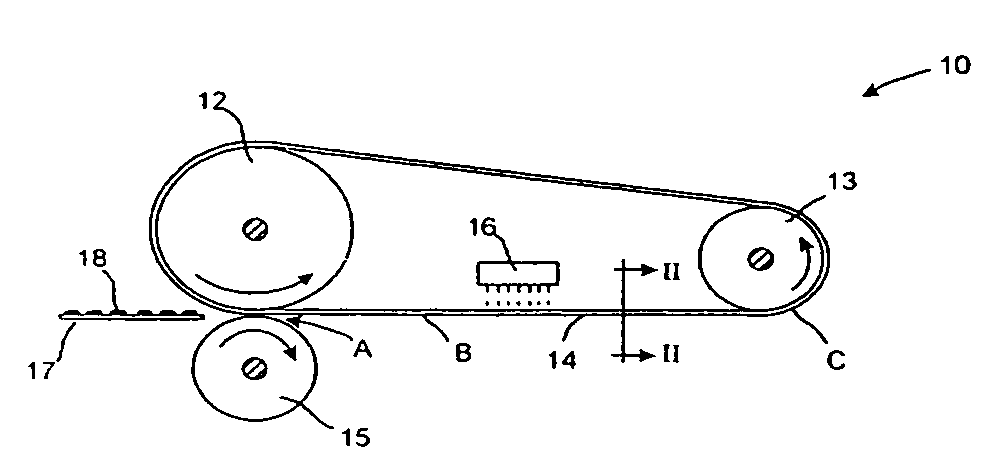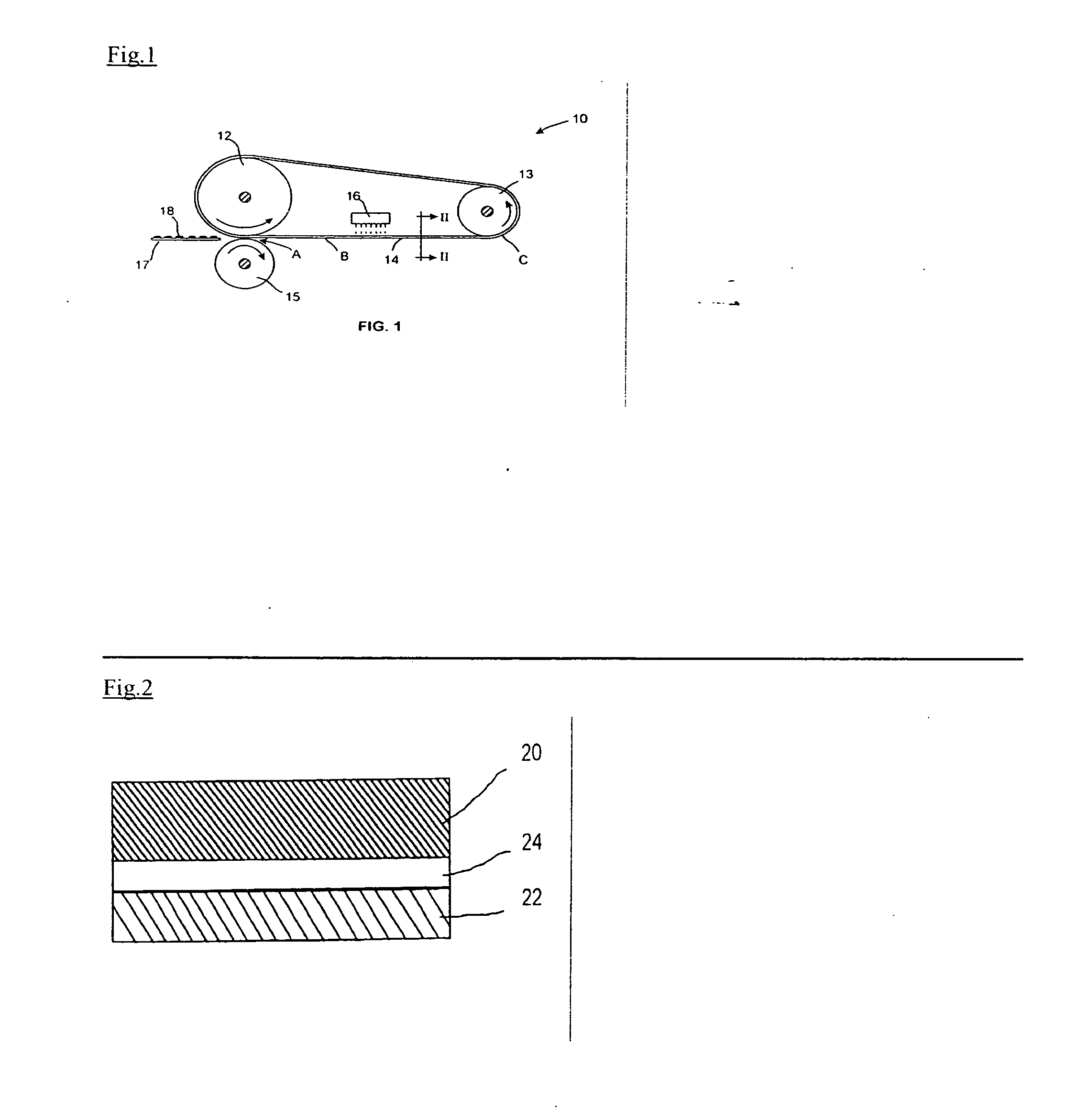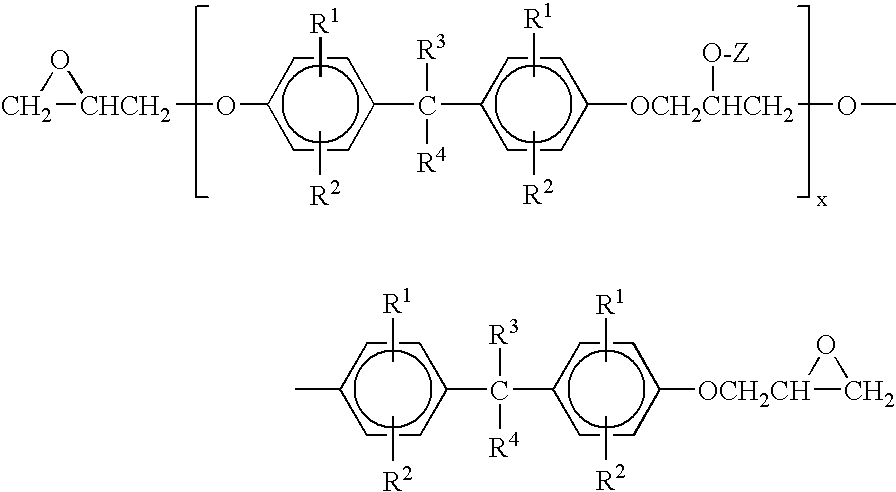Epoxy primer layer for fuser belts
a primer layer and fuser belt technology, applied in the field of composite tubular articles, can solve the problems of degrading the fusing performance of the member, uneven surface, and adhesion of heat-softened toner particles, and achieve the effects of good release of fused toner images, long life and high gloss
- Summary
- Abstract
- Description
- Claims
- Application Information
AI Technical Summary
Benefits of technology
Problems solved by technology
Method used
Image
Examples
example 1
Preparation of Epoxy Primer Layer Solution for Fuser Roller
[0052] A solution of 60 gm of ST4CAST™ W-66 epoxy resin in 240 gm THF is stirred overnight to give Part A.
[0053] A solution of 27 gm of the mixture of the pyromellitic dianhydride and hexahydrophthalic anhydride (Pyromellitic dianhydride:hexahydrophthalic anhydride=2:1 mole ratio) in 273 gm THF is shaken for 5 minutes to give Part B A polyimide belt substrate manufactured by Nitto Denko is cleaned with pressurized air to remove dust, cleaned first with acetone and then with alcohol using SPEC-WIPE™ and knitted polyester clean room wipers, and again cleaned with pressurized air. A solution of 15.38 gm of Part A and 15.38 gm of Part B was mixed for 5-10 minutes, then ring coated on the cleaned P.I. belt. The coated substrate is dried for 30 minutes, ramped to a temperature of 170° C. for 4 hours, and cured at 170° C. for 2 hours.
example 2
Preparation of Toner Fuser Belt with Silsesquioxane Surface Layer I
[0054] The silsesquioxane sol-gel GE AS4700 is filtered at room temperature by gravity through a Whatman glass microfibre filter GF / A.
[0055] Onto the cured epoxy primer layer P.I. belt, described in example 1, is coated with the GE AS4700 silsesquioxane sol-gel. This toner release layer is dried for 30 minutes at room temperature, ramped to a temperature of 150° C. over a period of 4 hours, held at 150° C. for 2 hours, and cooled to provide a fuser belt I-1.
example 3
Preparation of Toner Fuser Belt with Silsesquioxane Surface
[0056] To a 2 liter Erlenmeyer flask equipped with magnetic stirrer is added 220.8 gm of propyltrimethoxysilane, 73.2 gm of metyltrimethoxysilane, 73.2 of 3-glycidoxypropyl-trimethoxysilane, and 30.0 gm of 3-aminopropyltrimethoxysilane. After stirring for a few minutes, 64.8 gm of glacial acetic acid followed by 72 gm of water, are added dropwise from an additional funnel, and 122.79 gm distilled water is added from an additional funnel. The reaction mixture becomes exothermic and is cloudy at first but become clear after about half of water has been added. Following addition of the water, the flask is covered, and its contents are stirred overnight. Then 42 gm of a 70 wt % aqueous suspension of Ludox™ silica gel, whose pH has been adjusted from 8.9 to 4.3 by the addition of a few drops of acetic acid, is added dropwise. The mixture is again stirred overnight, and 627.6 gm of ethanol is added at a low flow rate through a fu...
PUM
 Login to View More
Login to View More Abstract
Description
Claims
Application Information
 Login to View More
Login to View More - R&D
- Intellectual Property
- Life Sciences
- Materials
- Tech Scout
- Unparalleled Data Quality
- Higher Quality Content
- 60% Fewer Hallucinations
Browse by: Latest US Patents, China's latest patents, Technical Efficacy Thesaurus, Application Domain, Technology Topic, Popular Technical Reports.
© 2025 PatSnap. All rights reserved.Legal|Privacy policy|Modern Slavery Act Transparency Statement|Sitemap|About US| Contact US: help@patsnap.com



